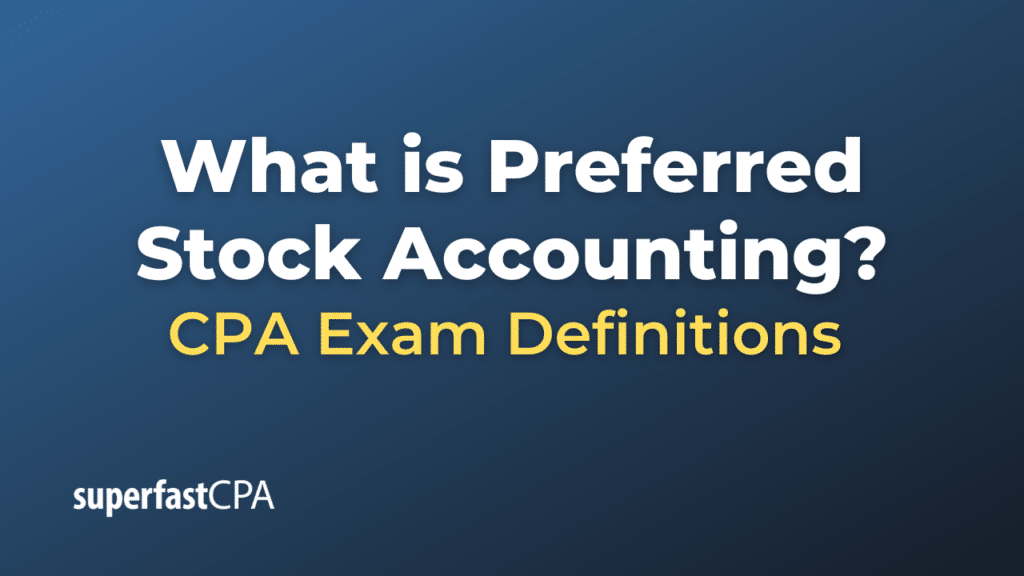Preferred Stock Accounting
Preferred Stock Accounting refers to the method of accounting for preferred shares issued by a corporation. Like common stock, preferred stock represents ownership in the corporation. However, preferred stock comes with a set dividend rate and usually has no voting rights. In the event of liquidation, preferred shareholders also have a higher claim on assets than common shareholders.
Here is how preferred stock is typically accounted for:
- Issuance of Preferred Stock: When a company issues preferred stock, it debits (increases) the cash account on the balance sheet for the total value received and credits (increases) the “preferred stock” account in the equity section of the balance sheet.
For example, if a company issues 1,000 shares of $100 par value preferred stock at par, the journal entry would be:
Debit Cash $100,000 (1,000 shares * $100)
Credit Preferred Stock $100,000
If the preferred stock is issued at a premium (above par value), the excess is credited to the “Paid in Capital in Excess of Par—Preferred Stock” account. - Dividends on Preferred Stock: When dividends are declared on preferred stock, the company debits (increases) the retained earnings (or dividends payable) account and credits (increases) the dividends payable account.
For instance, if a company declares a $5 per share dividend on 1,000 shares of preferred stock:
Debit Retained Earnings $5,000 (1,000 shares * $5)
Credit Dividends Payable $5,000
When the company pays the dividends, it debits (decreases) the dividends payable account and credits (decreases) the cash account. - Redemption or Repurchase of Preferred Stock: If a company repurchases its preferred stock, it would debit (decrease) the “preferred stock” account and credit (decrease) the cash account for the repurchase price. If the stock was repurchased at a price above the issuance price, the excess is debited to “Paid in Capital in Excess of Par—Preferred Stock” or to “Retained Earnings” if the excess is greater than the “Paid in Capital in Excess of Par—Preferred Stock” balance.
Please note that the specifics can vary depending on the features of the preferred stock and the accounting standards followed (such as US GAAP or IFRS).
Example of Preferred Stock Accounting
Let’s go through an example for each of the three accounting situations I mentioned earlier:
- Issuance of Preferred Stock
Let’s say that a company, TechFirm Inc., decides to issue 10,000 shares of $50 par value preferred stock for $60 per share. The accounting for this issuance would be as follows:
Debit Cash $600,000 (10,000 shares * $60)
Credit Preferred Stock $500,000 (10,000 shares * $50)
Credit Paid in Capital in Excess of Par—Preferred Stock $100,000 ($10 premium * 10,000 shares)
In this case, the preferred stock account is credited for the par value of the shares, while the excess received over the par value is credited to the “Paid in Capital in Excess of Par—Preferred Stock” account. - Dividends on Preferred Stock
Later, TechFirm Inc. declares a $4 per share dividend on these 10,000 shares of preferred stock. The accounting for this dividend declaration and payment would be as follows:
At the declaration date:
Debit Retained Earnings $40,000 (10,000 shares * $4)
Credit Dividends Payable $40,000
At the payment date:
Debit Dividends Payable $40,000
Credit Cash $40,000 - Redemption or Repurchase of Preferred Stock
Suppose that, after a few years, TechFirm Inc. decides to repurchase 1,000 shares of its preferred stock at $70 per share. The accounting for this repurchase would be as follows:
Debit Preferred Stock $50,000 (1,000 shares * $50)
Debit Paid in Capital in Excess of Par—Preferred Stock $10,000 ($10 originally received over par value * 1,000 shares)
Debit Retained Earnings $10,000 (Excess repurchase price over original issue price * 1,000 shares)
Credit Cash $70,000 (1,000 shares * $70)
In this case, the original amount received when the stock was issued is debited to the preferred stock account and the “Paid in Capital in Excess of Par—Preferred Stock” account. Since the repurchase price is higher than the original issue price, the excess is debited to retained earnings.
These are simple examples. The actual accounting can be more complex depending on the features of the preferred stock and the accounting standards followed.













